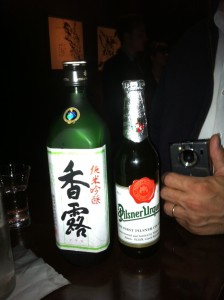I don’t always drink beer. But when I do, it’s usually Pilsner Urquell.
OK, that’s not true. It is usually from one of Japan’s quite passable large brewing companies. But without a doubt, my favorite beer in the world is Pilsner Urquell. And that tells you a lot about my preferences.
Sure, I enjoy Belgians, double-secret-probation stouts, and hopped-to-bejeezus IPAs as  well. They can be very interesting. But when no one else is around and I reach for a beer, if left to my own devices, I tend to gravitate toward simple, clean but far from insipid styles like Czech pilsners. Subtle and quaffable. ‘Nuff said.
well. They can be very interesting. But when no one else is around and I reach for a beer, if left to my own devices, I tend to gravitate toward simple, clean but far from insipid styles like Czech pilsners. Subtle and quaffable. ‘Nuff said.
Pilsner Urquell typifies these qualities. The clean, light backdrop lets the Saaz hops present flavors and aromas that are just present enough, but not overbearing. “Hodo-hodo” is the term in Japanese. Just enough – not too much.
I don’t always drink beer. In fact, I usually drink sake. And my preferences are of the same vein. In other words, I find aged sake, nama-zake, muroka nama genshu (read: the 2×4-upside-the-head of sake) intense yamahai sake, and other less orthodox styles to be fascinating. I never pass on tasting something, no matter how much funk may have overcome it – or be designed into it. They are all interesting, and almost all enjoyable, and all have their time and place.
But when no one else is around, and I want to quaff as I am wont to do, I reach for simple, subtle, hodo-hodo sake – like Koro.
Fortunately, there are many, many sake like Koro out there. So on any given day my options abound! And in truth, I do not drink Koro that often. But I single it out as it is made using Yeast Number Nine. In fact, the folks at Koro created Yeast Number Nine, or at least first isolated it. And they brew their sake to exemplify all that Nine can be.
I have written about Yeast No. 9 fairly recently in this blog; my point today is that Koro is  to sake what Pilsner Urquell is to beer. Everything I said about P.U. applies to Koro: simple, subtle, sippable, yet refined and exquisitely balanced. “Separated at birth,” so to speak. And, they were recently sighted together, a very rare occurrence, at a San Francisco establishment.
to sake what Pilsner Urquell is to beer. Everything I said about P.U. applies to Koro: simple, subtle, sippable, yet refined and exquisitely balanced. “Separated at birth,” so to speak. And, they were recently sighted together, a very rare occurrence, at a San Francisco establishment.
Neither stayed around very long, as you might imagine, but I did manage to get a rare shot of them together. They tend to hang in different circles, so it might be a while before we see them together again. Except at my house, that is.
~~~~~~~~~~~~~~~~~~~~~~~~~~~~~~~~~~~~~~~~~~~~~~~~~~~~~~~~~~~~~~~
Announcing the 10th
Sake Professional Course
to be held in Tokyo Japan, January 21 – 25, 2012
 From Monday, January 21, until Friday January 25, 2013, I will hold the 10th Japan-based Sake Professional Course in Tokyo, with a side trip to the Kyoto-Osaka-Kobe region. This is it: the most important thing I do all year, and beyond any doubt the best opportunity on the planet to learn about sake.
From Monday, January 21, until Friday January 25, 2013, I will hold the 10th Japan-based Sake Professional Course in Tokyo, with a side trip to the Kyoto-Osaka-Kobe region. This is it: the most important thing I do all year, and beyond any doubt the best opportunity on the planet to learn about sake. e” No Sake Stone Remains Left Unturned” is the motto, and “exceed expectations in that” is my goal. If you want to learn all you need to know about sake to function consummately as a sake professional at work, or if you are simply a sake lover with an insatiable appetite for sake-related knowledge, then this is the course for you. The course is recognized by the Sake Education Council, and those that complete it will be qualified to take the exam for Certified Sake Specialist, which will be offered on the evening of the last day of the course. Go here for more information. To reserve a spot, send an email to sakeguy@gol.com .
e” No Sake Stone Remains Left Unturned” is the motto, and “exceed expectations in that” is my goal. If you want to learn all you need to know about sake to function consummately as a sake professional at work, or if you are simply a sake lover with an insatiable appetite for sake-related knowledge, then this is the course for you. The course is recognized by the Sake Education Council, and those that complete it will be qualified to take the exam for Certified Sake Specialist, which will be offered on the evening of the last day of the course. Go here for more information. To reserve a spot, send an email to sakeguy@gol.com .









